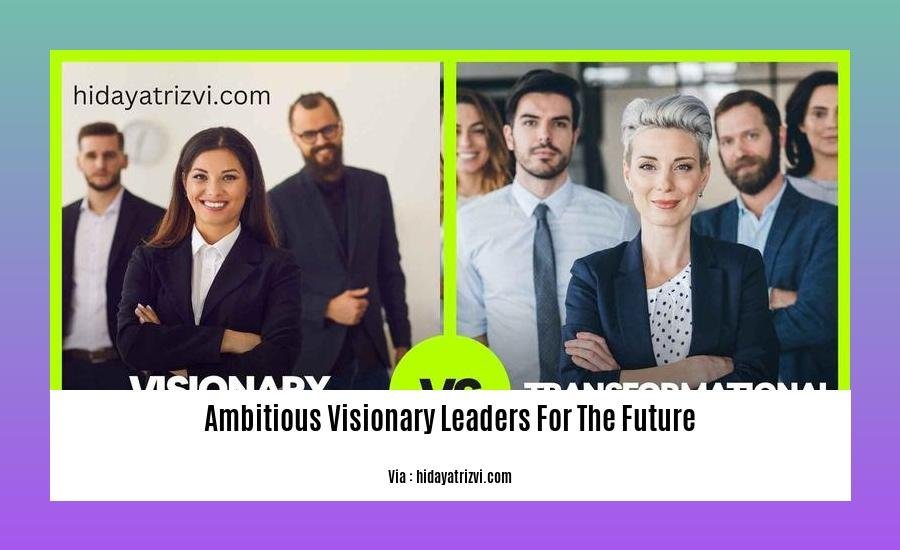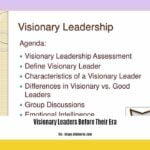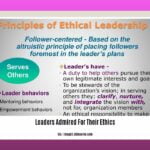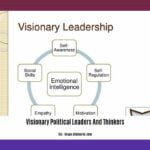Unlocking the Potential of Ambitious Visionary Leaders for the Future: In an ever-changing world, the need for ambitious visionary leaders who can drive innovation and shape a better tomorrow has never been more pressing. To fully unlock their potential, we must provide these leaders with the tools, resources, and support they need to succeed.
Key Takeaways:
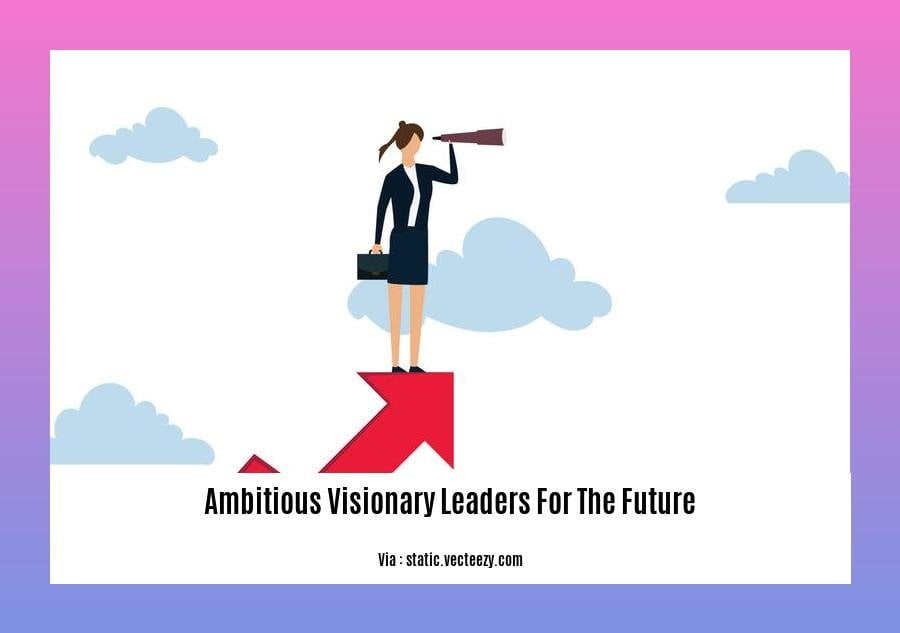
-
Characteristics of Visionary Leadership:
- Establishes a clear future vision
- Inspires and motivates others toward the vision
- Cultivates an environment for growth and goal attainment
-
Benefits of Visionary Leadership:
- Provides direction for innovation and success
- Fosters employee engagement and human-centric workplaces
Ambitious Visionary Leaders for the Future
In a world brimming with challenges and brimming with possibilities, we seek leaders—ambitious visionary leaders for the future—who possess the audacity to dream big and the wisdom to shape a better tomorrow. These leaders are not content with the status quo; they are driven by a burning desire to push boundaries, create transformative change, and leave an enduring legacy.
Visionary Perspective: The world needs leaders who see beyond the horizon, who can envision a future that is more just, equitable, and sustainable. They must have a clear and compelling vision that inspires others to follow them on this extraordinary journey.
Audacious Goals: Ambitious leaders set audacious goals that challenge the norm and propel us towards progress. They are not afraid to dream big, even if the path ahead is uncertain. Their unwavering determination to achieve these goals creates a culture of innovation and excellence.
Strategic Execution: Vision and goals are merely aspirations without strategic execution. Ambitious visionary leaders for the future are skilled at translating their vision into actionable strategies and executing them with precision. They adapt to changing circumstances and overcome obstacles with resilience and determination.
Sustainability and Responsibility: In today’s interconnected world, leaders must prioritize sustainability in all its forms—environmental, social, and economic. They understand that the success of future generations depends on the choices we make today. Embracing diversity and inclusivity, these leaders foster a sense of belonging and empowerment.
Inspirational Leadership: True leaders inspire their followers to reach their full potential. They communicate their vision with passion and conviction, motivating teams to go the extra mile. Creating a positive and empowering workplace culture, they empower others to think creatively and drive innovation.
Global Perspective: The future is global, and our leaders must possess a global perspective. They must understand the interconnectedness of the world and consider the impact of their decisions on a global scale. Collaboration and partnership are essential in addressing global challenges and creating a better tomorrow for all.
Nurturing and supporting ambitious visionary leaders for the future is paramount for the well-being of our societies and the planet. By embracing innovation, focusing on sustainability, and inspiring their followers, these leaders have the power to shape a future that is brighter, more equitable, and more sustainable for generations to come.
Learn about the political leaders celebrated for their vision who have shaped the world with their forward-thinking ideas. Explore the lives and contributions of visionary political leaders and thinkers who have inspired generations to come. Discover the forward-looking political leaders who are leading the way in creating a better future for all.
Strategic Execution: A Path to Success
Strategic execution transforms vision into tangible results. It’s the backbone of successful organizations, ensuring that strategies don’t just gather dust on shelves.
Key Principles for Strategic Execution
- Clear Communication: Everyone must understand the strategy and their role in executing it.
- Alignment: Goals, plans, and resources need to be aligned with the overarching strategy.
- Ownership: Empower teams to own their tasks and take responsibility for outcomes.
Steps to Successful Strategic Execution
- Define the Vision: Start with a clear, compelling vision that inspires and guides the organization.
- Set Ambitious Goals: Establish audacious goals that challenge the status quo and drive innovation.
- Develop a Robust Strategy: Create a comprehensive plan that outlines the steps to achieve the goals.
- Communicate Effectively: Ensure everyone is on the same page by communicating the strategy clearly.
- Empower Teams: Give teams the authority and resources they need to execute their tasks.
- Monitor Progress: Track progress regularly and make adjustments as needed.
Benefits of Strategic Execution
- Value Creation: Drives business value by translating strategy into tangible results.
- Enhanced Competitiveness: Improves market competitiveness by enabling organizations to adapt to changing market dynamics.
- Increased Stakeholder Satisfaction: Meets the needs of stakeholders by aligning strategy with their expectations.
Key Takeaways:
- Strategic Execution is the process of translating strategy into actionable plans and results.
- It requires clear communication, alignment, ownership, and empowerment.
- Successful Strategic Execution leads to value creation, enhanced competitiveness, and increased stakeholder satisfaction.
Citation:
Strategic Execution – Best Practices from a McKinsey Alum
Sustainability and Responsibility
Body:
-
Embracing Sustainability and Responsibility:
Leaders must prioritize sustainability and responsibility in all aspects of their decision-making, recognizing the long-term impact of their actions on the environment, society, and the economy. They promote practices that reduce carbon emissions, conserve natural resources, and foster inclusivity and diversity. -
Meeting Climate Policy Challenges:
Governments’ climate policies will significantly shape market dynamics. Visionary leaders align their strategies with these policies to stay competitive and navigate the complexities of the transition to a low-carbon economy. -
Honoring Climate Pledges:
Many companies have made climate pledges, but many are not on track to meet them. Ambitious leaders prioritize meeting these commitments, investing in renewable energy, improving energy efficiency, and implementing sustainable supply chain practices. -
Empowering CEOs as Sustainability Advocates:
CEOs play a pivotal role in driving sustainability and responsibility. They must lead by example, set clear sustainability goals, and allocate resources to support sustainability initiatives throughout the organization.
Key Takeaways:
- Prioritize sustainability and responsibility in decision-making.
- Align with climate policies to stay competitive.
- Meet climate commitments and invest in sustainable practices.
- Empower CEOs as sustainability advocates.
Citation:
- Bain & Company: Leading with Vision: Harnessing the Climate Policy Response
Inspirational Leadership
In today’s rapidly evolving landscape, inspirational leadership is no longer a luxury but a necessity. Visionary leaders with audacious goals and a focus on sustainability, innovation, and inclusivity are crucial to shaping the future.
Key Takeaways:
- Visionary Perspective: Envision a future that is just, equitable, and sustainable.
- Audacious Goals: Set challenging goals that push boundaries and inspire progress.
- Strategic Execution: Translate vision into actionable strategies and execute them with precision.
- Sustainability and Responsibility: Prioritize environmental, social, and economic sustainability.
- Inspirational Leadership: Motivate followers to reach their potential and create a positive workplace culture.
- Global Perspective: Understand the interconnectedness of the world and consider global impacts.
Characteristics of Ambitious Visionary Leaders
1. Visionary Perspective
These leaders possess a clear and compelling vision for the future that inspires and motivates others. They understand the long-term implications of decisions and embrace emerging trends.
2. Audacious Goals
They set audacious and challenging goals that push boundaries and drive innovation. They create a culture that encourages experimentation and risk-taking.
3. Strategic Execution
They develop and implement robust strategies to translate vision into reality. They adapt to changing circumstances and overcome obstacles with agility.
4. Sustainability and Responsibility
They prioritize environmental, social, and economic sustainability in all decision-making. They embrace diversity and inclusivity to foster a sense of belonging and empowerment.
5. Inspirational Leadership
They communicate effectively, motivate teams, and create a positive workplace culture. They empower and mentor others to develop their leadership potential.
6. Global Perspective
They understand the interconnectedness of the world and consider the impact of decisions on a global scale. They collaborate with partners and stakeholders to address global challenges.
Conclusion
Ambitious visionary leaders are essential for shaping a brighter future. By embracing innovation, focusing on sustainability, and inspiring their followers, they possess the power to transform industries, solve complex problems, and create a more just and equitable world. Identifying, supporting, and cultivating these leaders is crucial for ensuring a thriving society that meets the challenges of tomorrow with confidence and optimism.
Citation: Gallup: Successful Leadership: Create a Vision Through Inspiration
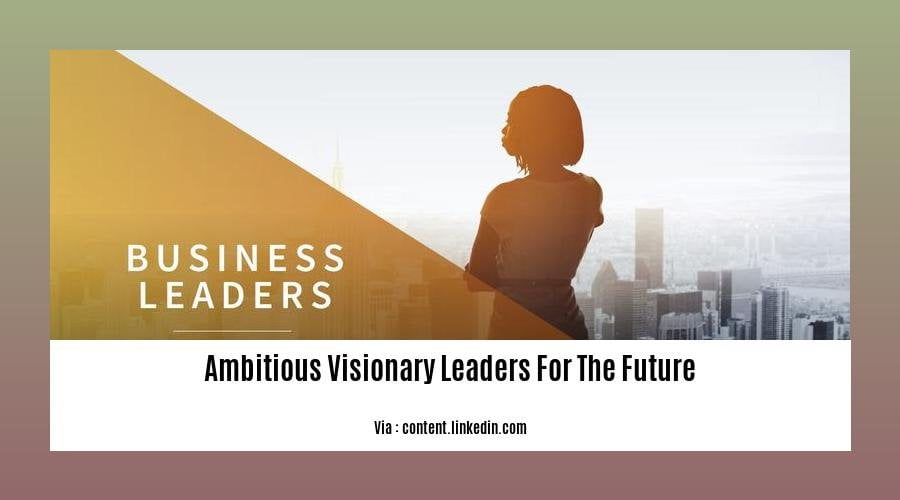
FAQ
Q1: What are the essential qualities of ambitious visionary leaders?
Q2: How can organizations cultivate and support the development of visionary leadership?
Q3: What are the key challenges and opportunities facing visionary leaders in shaping the future?
Q4: How can visionary leaders leverage diversity and inclusion to drive innovation and growth?
Q5: What strategies can visionary leaders adopt to create a sustainable and equitable future for all?
- Unveiling Bernhard Caesar Einstein’s Scientific Achievements: A Legacy in Engineering - July 15, 2025
- Uncover who is Jerry McSorley: CEO, Family Man, Business Success Story - July 15, 2025
- Discover Bernhard Caesar Einstein’s Scientific Contributions: Unveiling a Legacy Beyond Einstein - July 15, 2025
